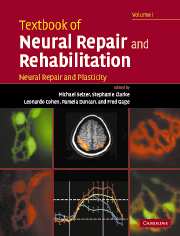Book contents
- Frontmatter
- Contents
- Contents (contents of Volume II)
- Preface
- Contributors (contributors of Volume I)
- Contributors (contributors of Volume II)
- Neural repair and rehabilitation: an introduction
- Section A Neural plasticity
- Section A1 Cellular and molecular mechanisms of neural plasticity
- Section A2 Functional plasticity in CNS system
- Section A3 Plasticity after injury to the CNS
- 13 Plasticity in the injured spinal cord
- 14 Plasticity after brain lesions
- 15 From bench to bedside: influence of theories of plasticity on human neurorehabilitation
- Section B1 Neural repair
- Section B2 Determinants of regeneration in the injured nervous system
- Section B3 Promotion of regeneration in the injured nervous system
- Section B4 Translational research: application to human neural injury
- Index
14 - Plasticity after brain lesions
from Section A3 - Plasticity after injury to the CNS
Published online by Cambridge University Press: 05 March 2012
- Frontmatter
- Contents
- Contents (contents of Volume II)
- Preface
- Contributors (contributors of Volume I)
- Contributors (contributors of Volume II)
- Neural repair and rehabilitation: an introduction
- Section A Neural plasticity
- Section A1 Cellular and molecular mechanisms of neural plasticity
- Section A2 Functional plasticity in CNS system
- Section A3 Plasticity after injury to the CNS
- 13 Plasticity in the injured spinal cord
- 14 Plasticity after brain lesions
- 15 From bench to bedside: influence of theories of plasticity on human neurorehabilitation
- Section B1 Neural repair
- Section B2 Determinants of regeneration in the injured nervous system
- Section B3 Promotion of regeneration in the injured nervous system
- Section B4 Translational research: application to human neural injury
- Index
Summary
Introduction
Throughout this century, neuroscientists have attempted to understand the neurological bases for functional recovery after brain injury (Ogden and Franz, 1917). But until a few years ago neural models were based on poorly understood processes such as diaschisis and substitution (Bach-y-Rita, 1987). At least short-term recovery from cortical injury probably involves the resolution of acute pathophysiologic processes in and around the site of injury. However, since improvement in motor abilities can continue for months, other mechanisms must play a role.
Neurophysiologic studies in animals and neuroimaging and non-invasive stimulation studies in humans over the past 10–15 years have begun to shed light on the neurological bases of motor recovery in greater detail. A common theme in many of these recent studies is that the cerebral cortex undergoes significant alterations in functional organization after peripheral and central nervous system injury, and after specific behavioral experiences (Merzenich et al., 1983; Donoghue and Sanes, 1987; Jenkins and Merzenich, 1987; Kaas et al., 1990; Chollet et al., 1991; Grafton et al., 1992; Nudo et al., 1992; 1996a; Cohen et al., 1993; Recanzone et al., 1993; Pascual-Leone et al., 1995; Seitz et al., 1995; Elbert et al., 1997; Karni et al., 1998; Kleim et al., 1998, and see Volume I, Chapter 8). The high level of interest in these plasticity studies stems from the assumption that the time course and extent of functional recovery is related to the time course and extent of cortical remodeling.
Keywords
- Type
- Chapter
- Information
- Textbook of Neural Repair and Rehabilitation , pp. 228 - 247Publisher: Cambridge University PressPrint publication year: 2006
- 1
- Cited by



